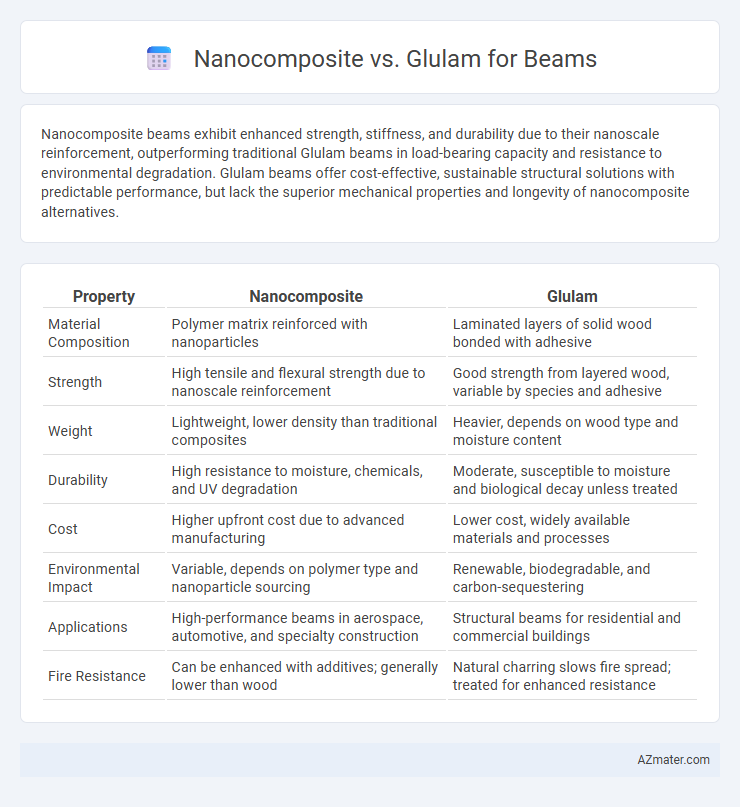Nanocomposite beams exhibit enhanced strength, stiffness, and durability due to their nanoscale reinforcement, outperforming traditional Glulam beams in load-bearing capacity and resistance to environmental degradation. Glulam beams offer cost-effective, sustainable structural solutions with predictable performance, but lack the superior mechanical properties and longevity of nanocomposite alternatives.
Table of Comparison
| Property | Nanocomposite | Glulam |
|---|---|---|
| Material Composition | Polymer matrix reinforced with nanoparticles | Laminated layers of solid wood bonded with adhesive |
| Strength | High tensile and flexural strength due to nanoscale reinforcement | Good strength from layered wood, variable by species and adhesive |
| Weight | Lightweight, lower density than traditional composites | Heavier, depends on wood type and moisture content |
| Durability | High resistance to moisture, chemicals, and UV degradation | Moderate, susceptible to moisture and biological decay unless treated |
| Cost | Higher upfront cost due to advanced manufacturing | Lower cost, widely available materials and processes |
| Environmental Impact | Variable, depends on polymer type and nanoparticle sourcing | Renewable, biodegradable, and carbon-sequestering |
| Applications | High-performance beams in aerospace, automotive, and specialty construction | Structural beams for residential and commercial buildings |
| Fire Resistance | Can be enhanced with additives; generally lower than wood | Natural charring slows fire spread; treated for enhanced resistance |
Introduction to Structural Beam Materials
Nanocomposite beams utilize advanced materials combining nanoparticles with traditional composites to enhance strength, stiffness, and durability, offering superior resistance to environmental degradation compared to conventional materials. Glulam, or glued laminated timber, is engineered by bonding multiple layers of lumber, providing notable load-bearing capacity, flexibility, and a sustainable alternative to steel or concrete in structural applications. Both nanocomposites and glulam present innovative solutions in structural beam materials, with nanocomposites excelling in performance enhancement through material science, and glulam offering eco-friendly and cost-effective advantages in construction.
Overview of Nanocomposite Beams
Nanocomposite beams consist of a matrix material reinforced with nanoparticles, enhancing mechanical properties such as strength, stiffness, and durability compared to traditional materials. These beams offer improved resistance to environmental degradation, better load distribution, and superior impact performance, making them suitable for advanced structural applications. Integrating nanomaterials into composite beams results in lightweight structures with high-performance characteristics surpassing conventional glulam beams.
Fundamentals of Glulam Beams
Glulam beams, composed of layered timber glued together, offer high strength-to-weight ratios and improved dimensional stability compared to solid wood, making them a popular choice in structural applications. Their fundamental design relies on the orientation and bonding of timber laminates, which distribute loads efficiently and resist bending stresses through a combination of elasticity and tensile strength. Unlike nanocomposites, glulam beams utilize natural wood fibers aligned longitudinally, providing predictable mechanical performance and ease of fabrication in large-span construction.
Mechanical Performance Comparison
Nanocomposite beams exhibit superior mechanical performance compared to Glulam beams, with increased tensile strength, flexural strength, and stiffness due to nanoscale reinforcement materials such as carbon nanotubes or nanoclay. Glulam beams, composed of laminated timber layers, provide high load-bearing capacity but generally have lower impact resistance and durability under varying environmental conditions. The enhanced interfacial bonding in nanocomposites leads to improved fatigue resistance and reduced deformation, making them ideal for advanced structural applications requiring long-term mechanical stability.
Durability and Environmental Resistance
Nanocomposite beams exhibit superior durability compared to glulam due to their enhanced resistance to moisture, UV radiation, and microbial degradation, resulting from the nanomaterials' ability to fill microvoids and strengthen fiber-matrix interfaces. Glulam beams, while structurally robust, are more susceptible to environmental factors like swelling, delamination, and fungal attack without proper treatment. The integration of nanocomposites significantly extends the lifespan of beams in harsh environments by improving mechanical properties and reducing maintenance needs.
Weight and Flexural Strength Analysis
Nanocomposite beams exhibit significantly lower weight compared to glulam beams due to the advanced nanoscale reinforcement materials integrated within their matrix, enhancing structural efficiency. Flexural strength analysis reveals that nanocomposite beams outperform glulam beams, offering superior load-bearing capacity and resistance to bending stress owing to the optimized dispersion of nanoparticles. The combination of reduced weight and improved flexural performance makes nanocomposites a viable alternative to traditional glulam in high-performance beam applications.
Sustainability and Eco-Friendliness
Nanocomposite beams exhibit enhanced sustainability through the use of engineered nanomaterials that improve mechanical properties while reducing the overall material footprint and extending service life. Glulam beams, made from renewable wood laminates bonded with eco-friendly adhesives, offer a low-carbon alternative with excellent biodegradability and carbon sequestration benefits. Both materials contribute to sustainable construction, but nanocomposites can optimize resource efficiency and durability, whereas glulam prioritizes natural renewability and recyclability.
Cost Effectiveness and Availability
Nanocomposite beams offer enhanced mechanical properties and durability but come with higher production costs and limited availability due to advanced manufacturing requirements. Glulam beams, composed of laminated timber, provide a cost-effective and widely available alternative, benefiting from established supply chains and easier fabrication. For projects prioritizing budget constraints and material accessibility, glulam remains the more practical choice compared to nanocomposite beams.
Application Suitability in Construction
Nanocomposite beams offer superior strength-to-weight ratios and enhanced durability, making them ideal for high-performance structural applications requiring lightweight yet robust materials. Glulam beams excel in aesthetic appeal and load-bearing capacity with excellent fire resistance, suitable for architectural projects and large-span constructions where natural wood appearance is desired. Both materials are viable for construction, but nanocomposites are preferred in innovative, lightweight designs, while glulam is favored in traditional and visually expressive wooden structures.
Future Trends in Beam Material Technology
Nanocomposite beams offer enhanced strength-to-weight ratios and improved durability through nanoparticle reinforcement, making them promising for future structural applications. Glulam, a traditional engineered wood product, is evolving with advancements in adhesive technology and sustainability practices to maintain its relevance in eco-friendly construction. Ongoing research prioritizes hybrid materials combining nanocomposites and glulam for optimized performance and environmental impact in next-generation beam technology.

Infographic: Nanocomposite vs Glulam for Beam
 azmater.com
azmater.com